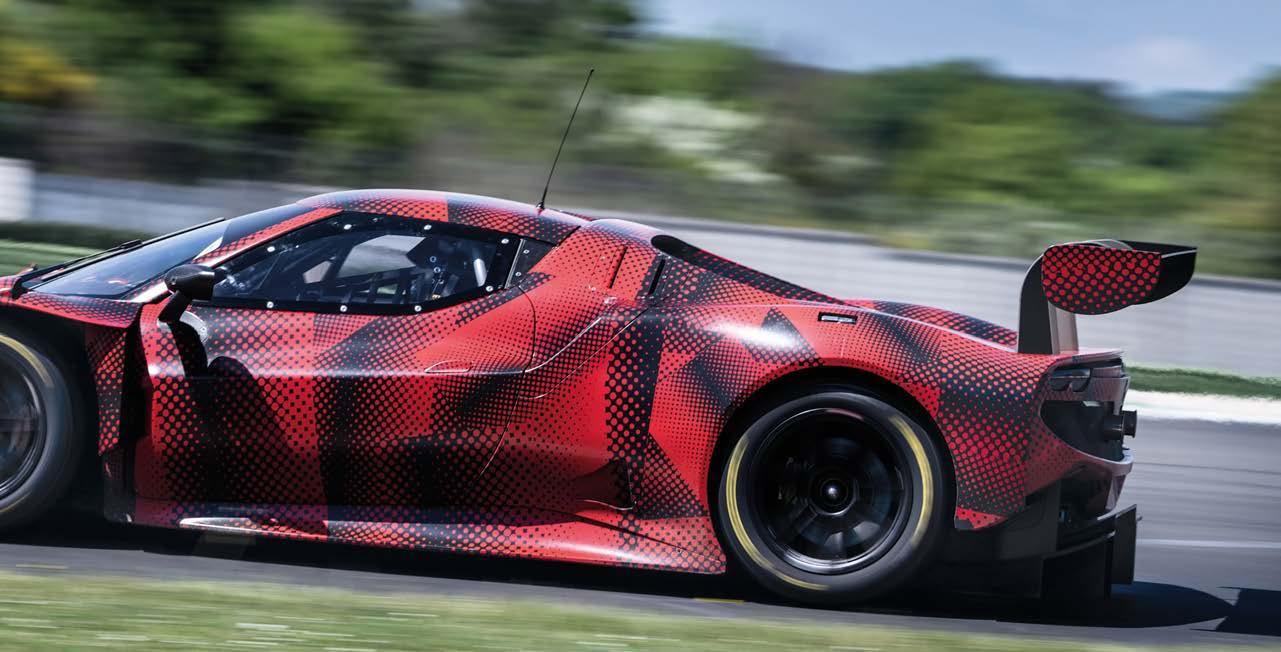
17 minute read
Ferrari 296 GT3
Thoroughbred

Ferrari has taken a novel approach to its new GT3 contender, taking advantage of new technical regulations to create a lighter, sti er, more accessible car than its predecessor

By ANDREW COTTON



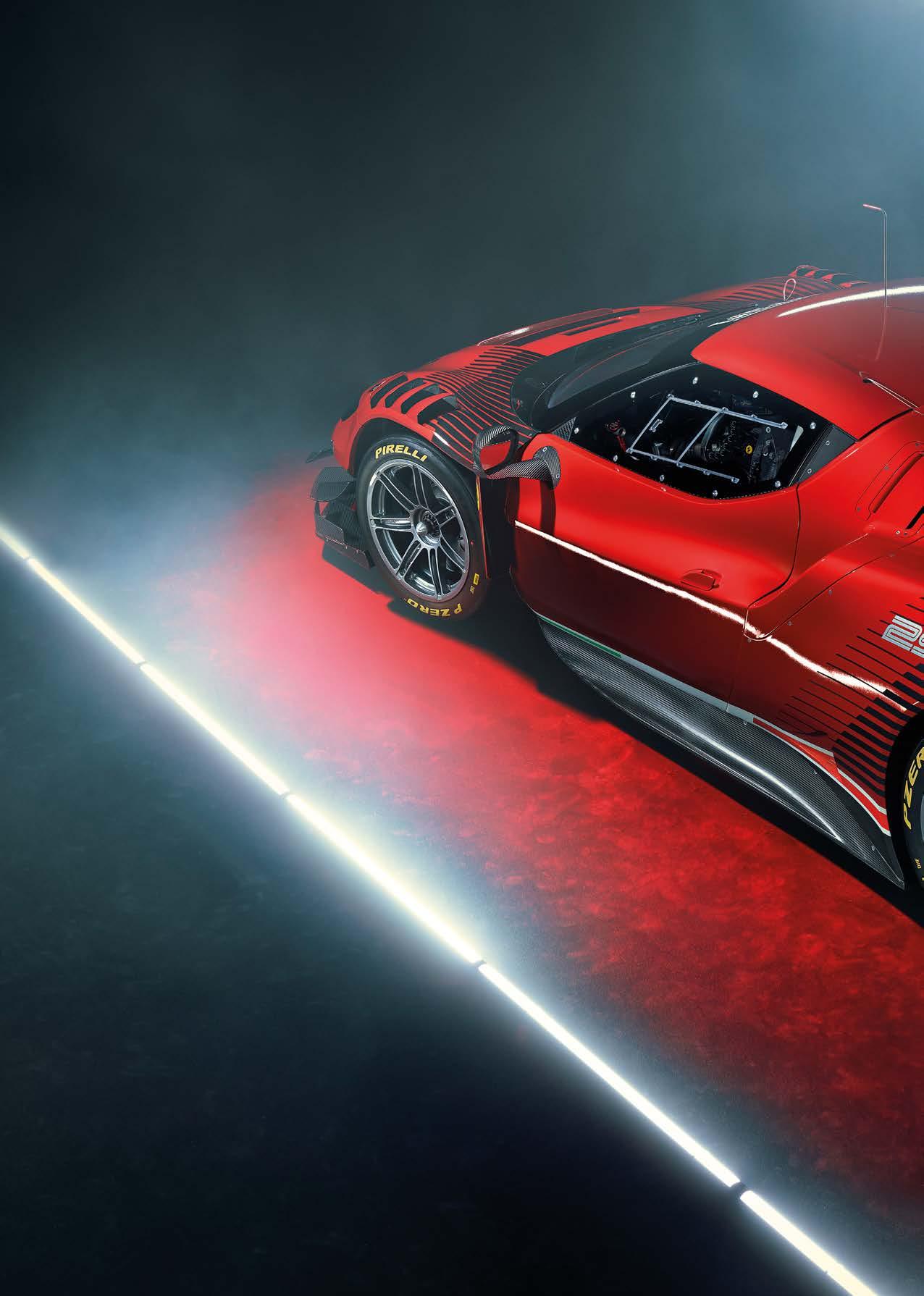

Ferrari has taken a radical new approach to the development of its 296 GT3 by taking full advantage of new regulations that allowed it to optimise the design from concept phase through to fi nal build. Rather than having to present new ideas to an FIA committee for approval, which slows up the process and introduces uncertainty, the new technical regulations that govern the class are written in stone, and that allowed Ferrari’s designers to focus on what they knew to be allowed from the start. That simplifi ed the design process and meant the team was able to aggressively pursue avenues that have helped to produce a better, less expensive car for its customers.
The car is based on the hybrid 296 GTB, though the hybrid system has been removed from the racing version in order to comply with the technical regulations for the class. Both the production and race cars share the 3.0-litre V6 architecture, with the twin turbos mounted within the 120-degree vee angle, although the internals are completely diff erent between the two engines.

Three degrees
The racing version has bespoke internals, a more robust design of pistons and conrods to improve reliability, and the whole engine is moved forward and down in the chassis to lower the overall c of g for the car to optimise longitudinal weight distribution. Exploiting the degree of freedom allowed by the technical regulations, the engine is also rotated three degrees tail up to allow for a more effi cient rear diff user.
The design team says it has carried over the strengths of the 488 GT3 and identifi ed its weak points in order to improve on them where possible in the 296. This was a process that was carried out by both the factory Competizioni GT and customer teams and drivers. That led to a simplifi ed rationalisation of the bodywork, more torsional rigidity, greater safety and improvements in areas outside the remit of Balance of Performance, such as braking effi ciency, driveability of the engine and adaptability to diff erent makes of tyre.
However, the biggest change is the application of prototype thinking to a GT car in terms of accessibility to key elements, with removable front and rear bodywork that allows engineers and mechanics better access to the engine and the gearbox.
‘On the bodywork, we took into consideration the racing inputs, and now the car is fully oriented to a racing application and operation,’ says Ferdinando Cannizzo, head of GT track car development at Ferrari. ‘The way that we did that was to

split the bodywork, giving us the possibility to make a very fast swap of parts during a race, improving operations in the pit and in the garage. The simplifi cation in the design in all areas made this possible, allowing us to have a sub assembly that is easy to manage.
‘Systems integration with body and chassis are completely diff erent to the 488, more like a Prototype than a GT car. That makes the car a real novelty.’
Regulation change

This generation of GT3 cars are built to a set of technical regulations written by the FIA with a view to fi rming up what is possible in the design of a car. Previously, manufacturers would design a car and then seek approval for it from a committee. Waivers would then be requested for various changes that were needed, but they were not guaranteed to be granted.
What this approach did was to allow the overall spirit of GT3 cars to be retained as extreme cars such as the Ford GT were rejected. The technical regulations now allow manufacturers to design with more certainty from the outset, which is obviously preferable for them.
Ferrari has used this change to improve its fi nal product, taking an integrated approach to the overall design from the outset, although there is still the age-old problem of engineers reading, designing and implementing what is not expressly written. If they choose to exploit that, there is a real risk the technology and concept will rise out of control, as has happened with the GTE cars.
‘Actually, the new GT3 rules are written as a proper technical regulation, but it does not bring a lot of changes,’ says Cannizzo. ‘Now we have a clear technical regulation, and the advantage with that is you know exactly what you can do, and what we can aff ord, in terms of technical design, without any risk of interpretation.
‘We can say that this was possible because it was granted in the past for our cars, but this gave us the possibility to start the concept phase knowing exactly what is and is not possible in GT3.
‘In the principle of freedom, we have the same freedom that we had in the past with the previous guidelines. There is no signifi cant change.’

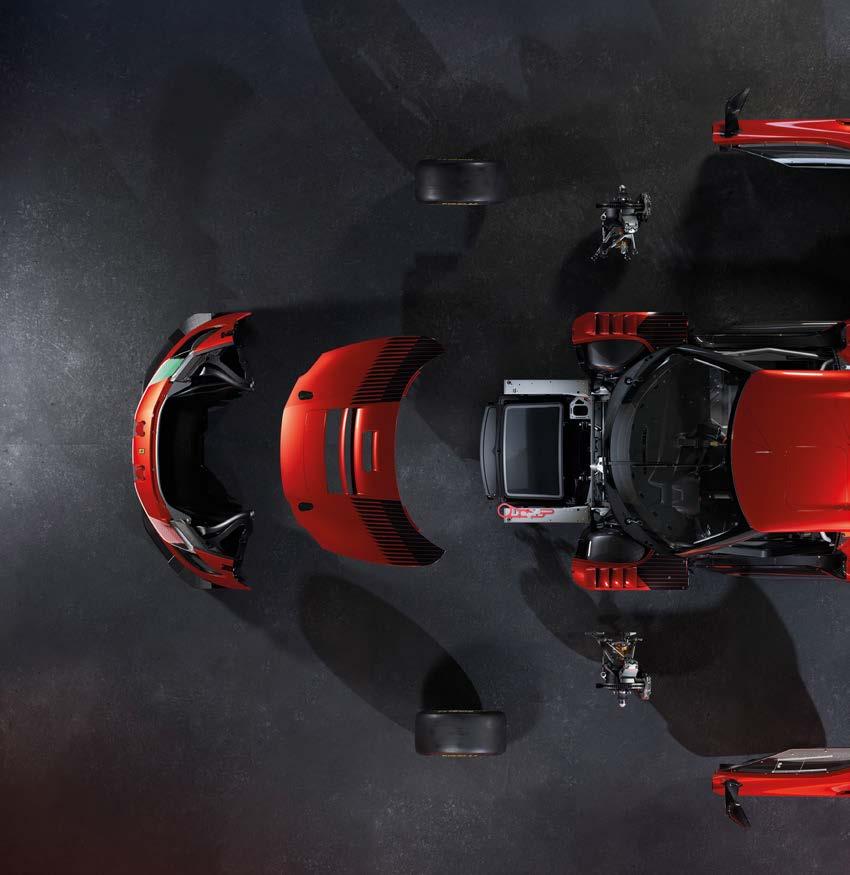
Priority targets
Faced with this new level of certainty, Ferrari attacked the design of the 296 with a view to reducing weight, lowering the c of g and increasing torsional stiff ness. They achieved the latter by an estimated fi ve to 10 per cent, but that was only part of the goal. The 488 was already strong in this area, so this was not the priority target for the design team.
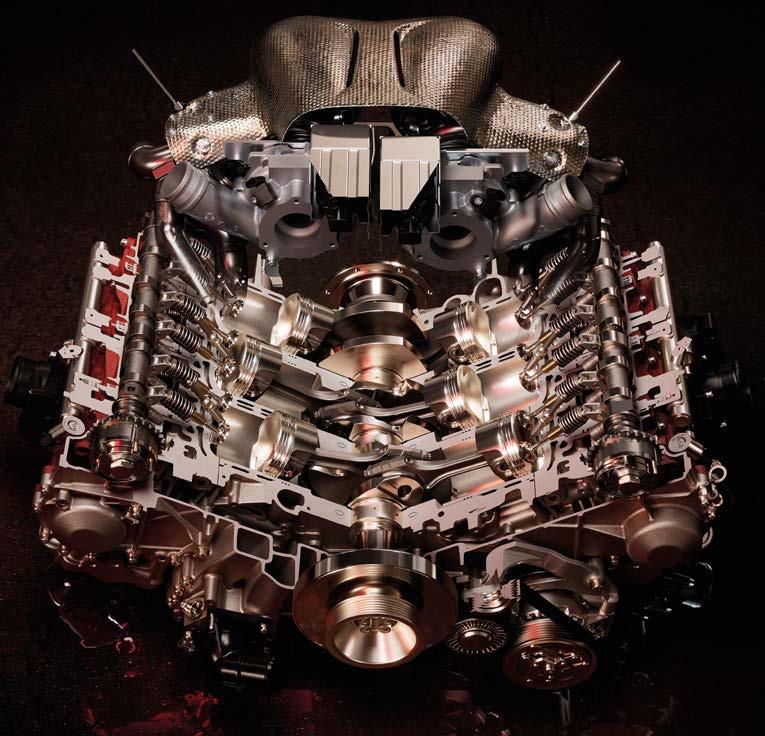
Power comes from a 3.0-litre V6 based on road car architecture but with racing internals. Twin turbos are mounted hot side in the vee
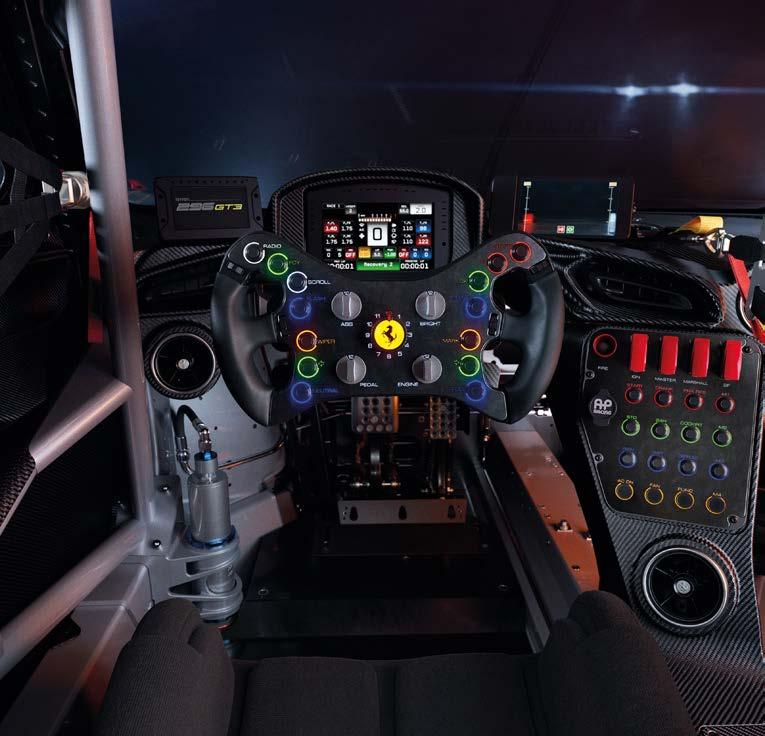
Multi-function programmable steering wheel also has a 12-layer shift control in the centre giving maximum functionality
Here’s where that Prototype thinking is most obvious. As well as improving packaging and making the car easier to work on in the pits, torsional stiffness has been improved and the c of g lowered through a lightweight design approach
Lowering the c of g through lightweight design was, and of this the team is particularly proud. The reduction in the number of cylinders, from eight in the 488 to six in the 296, helped in terms of the size and location of the engine, but the team worked hard to make significant improvements in all areas around the engine bay.
It might seem perverse for the team to target lowering the c of g while retaining the ‘hot side inside’ concept with its turbos relatively high up but, taken in context, it was still the right decision, maintains Ferrari.
‘You may argue that the turbocharger in the higher position than a cold vee configuration with the turbos on the side can lead to a higher c of g, but actually we were not focusing just on the engine, we were focusing on the whole car and the whole engine assembly, including all the ancillaries, and the benefits on the car installation pays for this technical solution,’ says Cannizzo.
‘You have to remember that the V6 is 120 degrees, so that’s a wide vee, and that gives us the possibility to have a lower installation of the turbochargers.
‘The hot vee configuration allows us to minimise the volume, and the losses of the air intakes and exhaust lines, increasing the efficiency of the turbo and limiting turbo lag as much as possible. As a consequence, that also allowed us to optimise the size of the intercooler.’
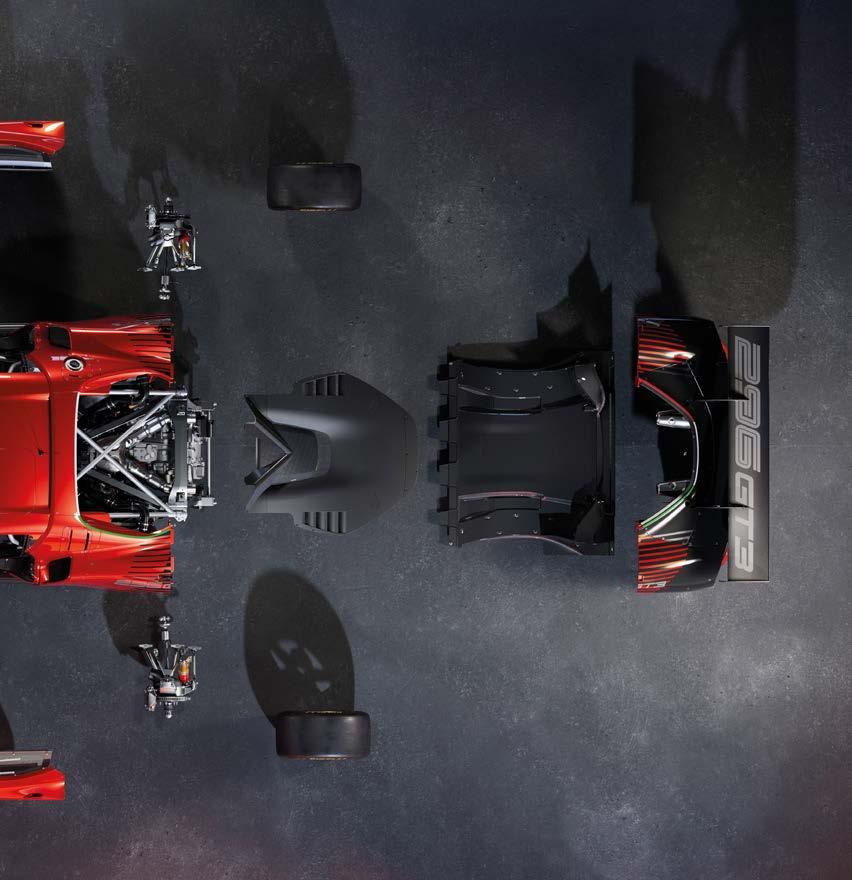
Improved cooling
‘We were able to improve the efficiency of the engine cooling system so we have a smaller radiator, and you can see the comparison between this and the 488,’ continues Cannizzo. ‘The radiator at the front is much smaller and gives the same heat rejection potential required because the target power is basically the same.’ Smaller radiators mean better aerodynamic efficiency, and less weight high up than its predecessor, which again helps overall car performance.
‘We made an interesting choice with the alternator to move it from the front of the engine, as it is generally mounted on the road cars, to the back, attached to the gearbox to improve the compactness of the assembly between the chassis and the engine, and optimise the stiffness of the assembly. It is now easy to access, easy to change and improves the packaging.’
However, it is the gearbox where things become more interesting. Ferrari’s designers worked hard on a bespoke external casing for the ’box to emphasise its integration with the engine, and make it compact and efficient.
The 296 boasts electronic gear change and clutch actuation, again improving efficiency. Having such systems makes it easier to calibrate and control according to conditions and driver, further improving driveability.
Naturally, a racing engine operates differently compared to a production engine, and in Ferrari’s case there was plenty of scope for changes to the internal mechanisms to allow it to run in more extreme conditions.
‘Clearly, many internal parts, such as the camshafts, cylinder liners, rods and pistons are specific for the racecar, mainly because we put the engine in a different operating condition than the road car and for reliability,’ explains Cannizzo.
Though the design team has not yet completed its on-track endurance validation for the 296 GT3 engine, they have also had to consider that the car will be using a different fuel in the near future, as all championships are planning to introduce a bio fuel, starting in 2023. The World Endurance Championship is already at that point, but further steps in that direction are expected.
Suspension and braking
While the road car features a double wishbone suspension at the front, a design that is shared but optimised for the racing version, the rear suspension is completely new. The race car also uses a racing-spec double wishbone design, and the team has gone for a five-way adjustable damper for the car.
‘We are working with one damper supplier, and we tried to optimise the damper itself, thanks to our supplier, as well as its installation on the car in order to cope with all potential different track requirements,’ confirms Cannizzo.
The team has retained the same brake supplier as on the 488, but has developed the system for the new car, increasing braking power with a larger diameter disc and an improved front caliper design.
‘At the rear things are different to make a better stiffness, specifically on the caliper,’ says Cannizzo. ‘The design has taken into consideration the possibility to have a quick change on the car in case of need, although the design target has been to not need to change brakes during long endurance races.
‘The c of g was already good there, but we optimised it in consideration of packaging of the suspension, the tyres and the accessibility of components in the car.’

Cockpit constraints
One of the major concerns for the design team was the volume of the cockpit from the donor car, and how that would marry up to the new technical regulations concerning driver seating position, and the seat itself. The team had to find a way of meeting these new regulations while also maintaining good accessibility in and out of the car during the pit stops.
Seating position is more closely matched to the rear-most part of the rollcage. Ferrari worked with two seating positions, for small and large drivers, while also retaining access to a driver’s head through the mandatory hatch in the roof of the car.
‘We have a new regulation for the seat, and our donor car is pretty small in terms of volume,’ says Cannizzo. ‘A lot of work was done to optimise the applicability of the car for bigger drivers, which was not easy for us considering the constraint of the cockpit from the technical regulations.
‘The rollcage has been optimised compared to that used on the 488 and it is now much more integrated with the roof of the car, so it is not just an add on, it is fully integrated with the road car structure at the top. That gave us bigger volume and allowed the required distance between the helmet and the ’cage, specifically for tall drivers.
‘The pedals and steering wheel are adjustable to better match with the XL seat for bigger drivers and the medium seat for smaller, professional drivers. This was introduced in the 488, but we were forced to review the design to cope with the change in the technical regulations, which no longer allows going beyond the rear rollcage line and reduces the space in longitudinal position for the drivers.’
The steering wheel is multi-functional but the digital read out is mounted on the dashboard in order that amateur drivers are still able to read the data, even midcorner. The wheel itself is programmable and from there the driver can select traction control, abs, pedal and engine maps and launch control settings, alongside the more commonly used dials for pit speed limits and radio. A rotary dial with the Prancing Horse in the middle of the steering wheel allows up to 12 layers shift for each button, extending the functionality to the utmost level.
In terms of safety, the racecar will use the front and rear crash structure of the road car, which are sufficient for it to meet the crash testing requirements of the GT3 regulations.
Aerodynamics
The donor 296 is completely different to the 488, but the team has made the most of its new design approach under the skin to make the top surface of its new car more efficient. As mentioned, the radiators are smaller than previously used, which means smaller air inlets and greater efficiency.
Carried over from the 488 Evo kit is the high lip concept on the front splitter, which helps to feed air to the rear diffuser. While the front downforce numbers are therefore compromised, the approach helps the car’s overall balance, as Cannizzo explains: ‘It is easy to grab front downforce, but that will kill the rear downforce. The compromise is to have the right aero balance between front and rear, but more than that, the minimum pitch sensitivity of the car. The car can change attitude without changing the aero balance and that is minimised in this design.’
One of the most identifiable changes is the rear wing mounting that is now a swan neck design, with the fixing points arching towards the rear of the car and mounting on the top surface of the wing. The rear wing end plates are similar in size to those on the 488 GT3 but with a different trim to avoid adjusting position for each angle of attack.
While others have mounted the rear wing from the rear, retaining clean airflow to the leading edge of the wing, Ferrari decided that approach was of minimal advantage.
‘We have changed the pick-up points, so to hold the wing from the top and not the bottom. That is the biggest change on the car,’ says Cannizzo. ‘You can say that having a clean leading edge on the
Ferdinando Cannizzo
Aerodynamic package includes a high lip front splitter feeding a large rear diffuser and a new, swan neck-mounted rear wing. The design concept is to optimise balance and minimise pitch sensitivity, making it a more driveable car for amateur drivers
wing makes it work better, but overall, we have explored that possibility and, in terms of packaging, we found this to be much better in terms of minimising the weight of the overall wing assembly.
‘This is also quite stiff, and it complies with the technical regulation that the wing needs to be rigid, and not have any compliance. From a pure aerodynamic perspective, I don’t think you would gain much by cleaning this area of the wing.’
The different trim on the rear wing end plates means the wing can be adjusted without needing to move them up or down to comply with the homologated box.
The team has also increased visibility at night through improved lighting from the car. The standard lights produce the same number of lumens as the 488 fitted with the complete 24-hour race package, and so on the car’s debut at Daytona in January with an all-new light package, the Ferrari drivers will benefit from a greater depth of view.
Ferdinando Cannizzo
Assembled by ORECA
The other major change for this generation of Ferrari GT3 is that French team, ORECA, won the contract to build it and support customer teams, replacing Michelotto. ORECA has since ramped up its facility in Signes to meet what is expected to be high demand for the 296 GT3.
Ferrari designed the new GT3 car in house at Maranello, and used the expertise of ORECA to finalise the concept.
‘The major role for them was to finalise the design, which is what they have done, and assemble the car,’ confirms Cannizzo. ‘Ferrari is taking care of the concept choices, and the first design of the car. We changed the equilibrium by outsourcing the [rest of the] job.
‘What ORECA gave us is a different perspective and new ideas, things we have integrated into the car. They are very experienced, and this combination of fresh eyes gave us a lot and the integration was very good.
‘We worked together to overcome the weak points of the 488 GT3, mainly by simplifying the general layout and the bodywork assembly, as well as cleaning up the electrical wiring to facilitate pit operations, improve mechanics’ assembly and reduce time and repair costs.’
The final design of car can be split into three parts: the front splitter, bonnet and bumper that can be easily detached to allow access to the front suspension and braking system; the main chassis that is designed as a monocoque; and the rear engine deck, bumper and diffuser. Removal of this allows access to the engine, gearbox and rear suspension, Ferrari hoping that the days of mechanics upended in the engine bay to work on its cars are behind them.
The overall result is a car that should be a step change improvement compared to the 488 it replaces.
‘We worked in all areas that are not constrained by the regulations or monitored by the Balance of Performance, such as weight distribution, dynamic stability, aero sensitivity and suspension design that allows us to exploit the most from the tyre usage and improve consistency. These are the areas we focused on at the design and concept stage,’ concludes Cannizzo.
‘The other point we are trying to improve with the Prototype approach is to design the torsional and bending stiffness of the car. Starting from the front crash structure, chassis, engine and gearbox were all considered at the same time in order to have a clear target for the entire car. We were able to simplify the design to reduce the running costs of the car, too. That was something important for our customers.’
The car will continue track testing through the remainder of 2022, and will hit the track for the first time in competition at Daytona in January 2023.
